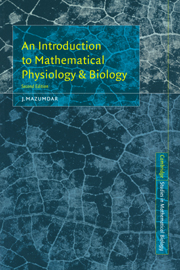Book contents
- Frontmatter
- Contents
- PREFACE TO THE SECOND EDITION
- PREFACE TO THE FIRST EDITION
- Chapter 1 DIMENSIONAL ANALYSIS IN MATHEMATICAL PHYSIOLOGY
- Chapter 2 THE MATHEMATICS OF DIFFUSION
- Chapter 3 POPULATION BIOLOGY
- Chapter 4 BIOGEOGRAPHY: MATHEMATICAL ANALYSIS OF WILDLIFE RESERVES
- Chapter 5 PHARMACOKINETICS: DRUG DISTRIBUTION IN PHARMACOLOGY
- Chapter 6 MATHEMATICAL MODELLING IN EPIDEMIOLOGY
- Chapter 7 MODELLING THE AIDS EPIDEMIC
- Chapter 8 BIOLOGICAL FLUID MECHANICS
- Chapter 9 ANALYSIS AND APPLICATIONS OF LEFT VENTRICULAR MECHANICS
- Chapter 10 ANALYSIS AND APPLICATIONS OF HEART VALVE VIBRATION
- Chapter 11 MEDICAL DEVICES
- GLOSSARY OF TERMS
- REFERENCES
- INDEX
Chapter 2 - THE MATHEMATICS OF DIFFUSION
Published online by Cambridge University Press: 05 June 2012
- Frontmatter
- Contents
- PREFACE TO THE SECOND EDITION
- PREFACE TO THE FIRST EDITION
- Chapter 1 DIMENSIONAL ANALYSIS IN MATHEMATICAL PHYSIOLOGY
- Chapter 2 THE MATHEMATICS OF DIFFUSION
- Chapter 3 POPULATION BIOLOGY
- Chapter 4 BIOGEOGRAPHY: MATHEMATICAL ANALYSIS OF WILDLIFE RESERVES
- Chapter 5 PHARMACOKINETICS: DRUG DISTRIBUTION IN PHARMACOLOGY
- Chapter 6 MATHEMATICAL MODELLING IN EPIDEMIOLOGY
- Chapter 7 MODELLING THE AIDS EPIDEMIC
- Chapter 8 BIOLOGICAL FLUID MECHANICS
- Chapter 9 ANALYSIS AND APPLICATIONS OF LEFT VENTRICULAR MECHANICS
- Chapter 10 ANALYSIS AND APPLICATIONS OF HEART VALVE VIBRATION
- Chapter 11 MEDICAL DEVICES
- GLOSSARY OF TERMS
- REFERENCES
- INDEX
Summary
The Process of Diffusion
Consider a solution in which simple molecular diffusion is taking place. A solution consists of a fluid, called the solvent, in which some matter, called the solute, has dissolved. The composition of the solution is characterized by its mass concentration C, which is the mass of dissolved matter per unit volume of liquid. For example, the water content of cells is approximately 80%, and water is known as the universal biological solvent.
One means by which the solute molecules are dissolved and transported through the solvent is diffusion. Thus, diffusion is the process by which matter is transported from one part of a system to another as a result of random molecular motion.
Diffusion processes play a very important role in almost any biological phenomenon. Through diffusion many metabolites are exchanged between a cell and its environment or between the blood stream and tissues.
The diffusion mechanism is the consequence of the thermal motion of the individual solute molecules. The continuous motion of the solvent molecules produces a great many collisions with, say, a given large solute molecule. As a result, pressure fluctuations are produced which in turn impart to the solute molecule a jerky irregular path named a random walk. The result of this random walk is a net displacement of the molecule in some direction. The same phenomenon occurs in the case of suspended particles, e.g. pollen in water or emulsions.
- Type
- Chapter
- Information
- An Introduction to Mathematical Physiology and Biology , pp. 12 - 37Publisher: Cambridge University PressPrint publication year: 1999
- 1
- Cited by



